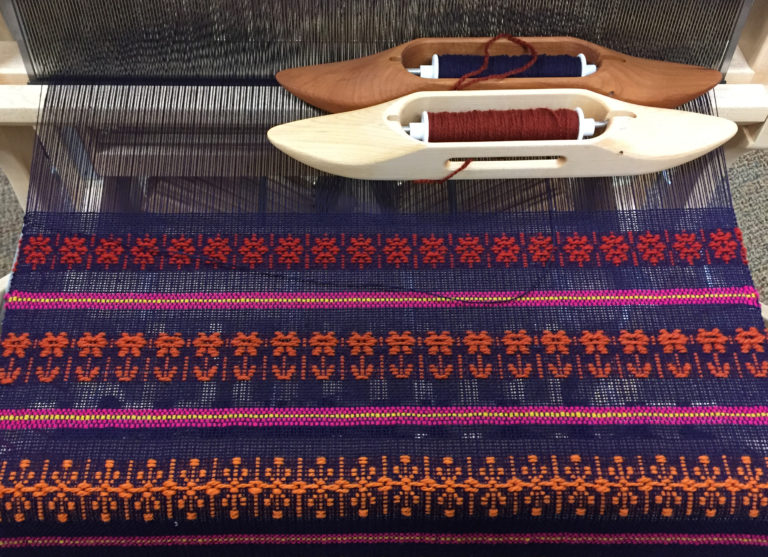By Jane Patrick
I love patterns in weaving and I especially am captivated by rosepath, a member of the twill family of weave structures. Like only weavers can understand, I get a kick out of threading up a loom and exploring patterns by changing the tie-up and treadling for many different variations. This may all seem obvious, but I find that weavers often forget that many patterns can be woven on the same threading by just changing the tie-up and treadling.
Rosepath is a point twill broken by a thread at the turning point. It is a favorite of mine because it can be so incredibly versatile—so thread up your loom with a long warp and play, play, play. Note: rosepath can be woven on 4 shafts as well, but the advantage to threading rosepath on eight shafts, is that you have so many more possibilities. If you just have four shafts, check out Marguerite Porter Davison’s A Handweaver’s Pattern Book. It is now out of print, so if it’s not already in your weaving library, look online for a used book with the original (green) cover.
Here is a comparison of regular point twill and a rosepath threading:

point twill

rosepath
It is the thread on shaft 1 between the ascending and descending threads, that’s the charm of rosepath.
You can find patterns in books and use them as is or you can also use them as a jumping off place for variations by messing around with the pattern on a drafting program. This is a great way to check out ideas before weaving them—saves time and expands your ideas. For example, what happens if you lift 1456 instead of 1568? You can quickly find out by plugging that into a drafting program as well as many other variations. Here in the office we use Fiberworks (which we hear will soon have an update).
For this project we used the many delightful patterns designed by Sally Nielsen beginning on page 30 in A Weaver’s Book of 8-Shaft Patterns by Carol Strickler.



The impetus for this project was warping our new Wolf Pup 8.10 for the Vav Conference in Sweden which Barry and I attended last summer in Vaxjo, Sweden. I wanted something fresh that had a Scandinavian look. These rosepath patterns were just the ticket. For the warp we used 10/2 pearl cotton in dark purple and 8/2 cotton in grape for weft. The pattern weft is Finullgarn from Limmo Design in earthy shades. We sett the warp at 18 epi and used floating selvedges. (A floating selvedge is a thread at either selvedge that is not threaded in a heddle. It floats between the threads that are raised and the ones that are stationary or lowered. It is used when you are weaving a pattern where your edge thread is not caught every row. When entering the shed, place the shuttle over the floating selvedge, when exiting the shed, go under the floating selvedge. After a while it becomes automatic.)
Rosepath can be woven with or without a tabby weft. (Tabby is alternating plain weave rows between pattern rows.) The times you want to use tabby are when you are weaving a supplementary pattern that might have longer floats or repeating rows. The tabby background keeps the fabric stable. The pattern weft floats on top of the background and provides all of the excitement. (If you are having trouble visualizing this, think of overshot or summer and winter.)
When you look up Sally Nielsen’s drafts, you’ll find that sometimes patterns will take more treadles than will be available on your loom. What to do? One possibility is to alter the pattern somewhat in a drafting program to fit the available treadles. The other is to use a great free tool, Tim’s Treadle Reducer: https://www.cs.earlham.edu/~timm/treadle/form1.php You just type in your tie-up and treadling and it’ll convert it to your available treadles. That’s what expert weaver Betty Paepke (our Schacht shipping clerk) did to weave the patterns shown here.
We used two shuttles, one for the tabby and the other for the pattern weft. We wound separate bobbins for each of the pattern colors, as well as the blue and orange plain weave stripes between each of the pattern rows. We beat the pattern to square for a balanced weave.
Here we’ve used different pattern motifs, but you could just repeat a single motif for an allover design. These rosepath designs would also make wonderful borders on runners or napkins. You’ll find many other uses as well. Happy weaving!

